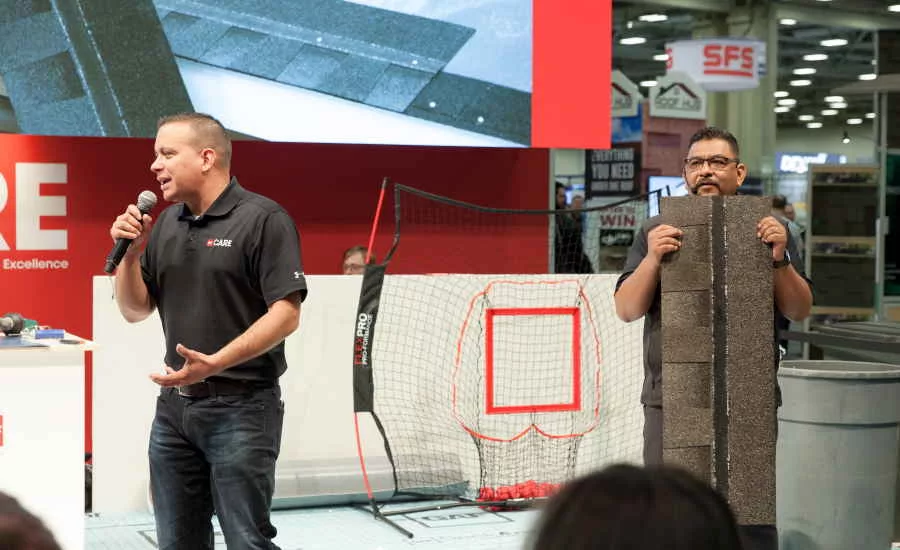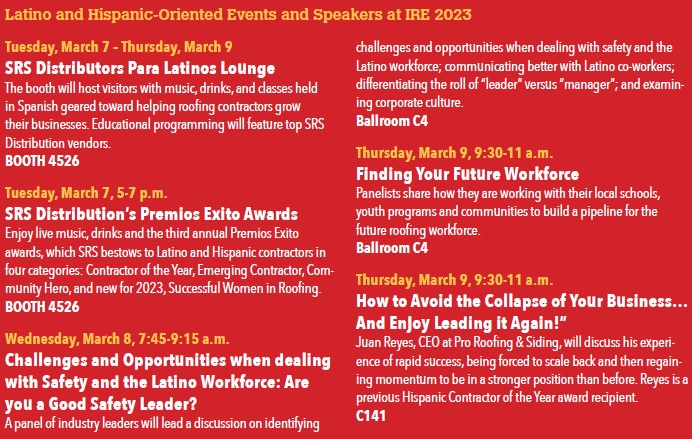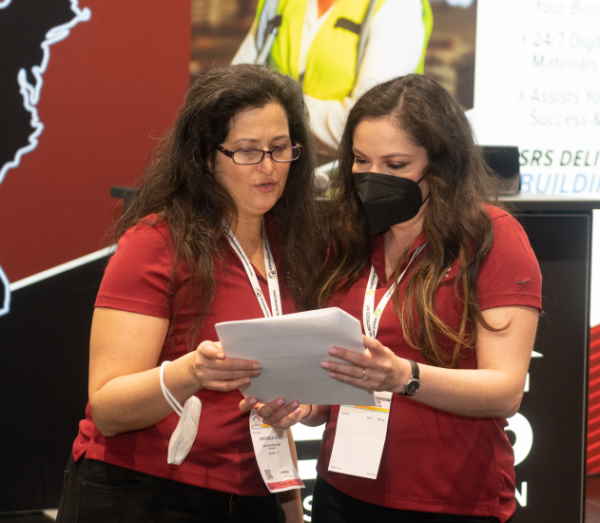Engaging Latino and Spanish-Speaking Contractors at IRE

The team at SRS Distribution introduced the Para Latinos Lounge at the 2022 IRE in New Orleans and will be back on the show floor this year in Dallas. Photo by J.R. Thomason.

Members of the GAF CARE team conduct a live product demonstration completely in Spanish on the show floor during the IRE in Dallas in 2020.
Si está leyendo esto y tiene problemas para entender lo que significa, sabe cómo se sienten muchos techadores Latinos e Hispanos, pero las cosas están cambiando.
Most readers recognize the previous sentence is in Spanish, but do you understand what it says? No? If not, don’t feel bad. The U.S. Census Bureau notes only 20% of Americans are fluent in a second language, a deficit impacting the roofing industry, among other trades. It is also one of the drivers leading SRS Distribution to open its Para Latinos Lounge, now in its second year, at the 2023 International Roofing Expo (booth number 4526).
Para Latinos Lounge is the brainchild of Julissa Chavez, program manager, Latino sales and marketing at SRS, and whose idea for an exhibit space — dedicated to Latino and Hispanic roofers and contractors — was an outgrowth of her responsibility to build relationships with that community for SRS. [See Info Box for Para Latinos Events]
“The purpose of our booth is really as an educational lounge,” Chavez explained. “Everything in the booth is in Spanish and we have partnered up with a lot of our vendors … educating our contractors with business solutions, with better practices and networking opportunities.”
Chavez said the idea originated with her previous role as a territory manager in SRS’s Atlanta market, where she sought to capture a larger share of the Latino and Hispanic business given she’s both Latina and bilingual.
“In my experience, I would go make relationships, but then when new [Latino] contractors came into our branches, there was [a] disconnect because nobody speaks Spanish,” she said. “So, I would just go through that journey with my new customers, like filling out a credit application.”
That language barrier often required her to be onsite to help train customers on installing certain products because vendors couldn’t effectively communicate with many Latino clients, noting how “I would have to translate the whole installation training.”

Figures from the Bureau of Labor Statistics say around 30% of roofing contractors identify as Latino and Hispanic, and if you’re not bilingual, it’s often one more barrier to career advancement facing America’s largest ethnic minority. The U.S. Census Bureau’s latest numbers show that Latino and Hispanic individuals now account for more than 18% of the total U.S. population. African Americans are the second largest minority group at 12.1%.
According to Lorna Rojas, a human resources recruiter for Tremco Inc., the language barrier requires solutions. However, she noted, ethnic understanding is just as crucial.
“I think we really need to educate leaders,” said Rojas, who will join a breakout session panel discussing safety issues affecting the Latino workforce at the show. “There's a lack of cultural skills in the leadership of the roofing industry and I think that has caused a lot of trouble attracting new potential employees.”
Rojas emphasized how the dedication of the Latino and Hispanic workforce is paradoxically unquestioned; putting family first — which, she said, is at the center of the community’s culture — can sometimes be misunderstood as being lackadaisical by employers.
“Something that I can say about Latino workers is they will be there whenever you need them,” Rojas said. “You can … tell them that they need to work Saturday and Sunday, and they will work, but don't tell [them] they [can’t] have an hour to go to a family event or something.”
As the U.S. continues to become a majority-minority nation, demand for multilingual contractors will only increase. According to the career website Zippia.com, after English, the second most-spoken language is Spanish — by a long mile at 82% — and no other language comes close.
While Zippia statistics cite a majority of roofing contractors remain white, at 57%, Latinos contractors now account for 30% of all roofing professionals, which is a 40% increase from 2010, when the figure stood at 11%.
Moreover, information compiled by The Center for Construction Research and Training determined that roofing has the highest percentage of Latino and Hispanic workers in the construction industry as a sector. And, the further south one travels within the continental U.S., the share of Hispanic and Latino roofing contractors grows proportionally, with Texas, Arizona, Nevada, California and Florida home to the largest pro rata share of workers.
 Photo by J.R. Thomason.
Photo by J.R. Thomason.
A white paper by the building products marketing and public relations firm Kleber & Associates titled “How to Reach Hispanic American Contractors and Homeowners" dubbed the findings as "A Trillion Dollar Opportunity." The conclusion makes sense when looking at the size, scope, and economic clout of the estimated 62.1 million consumers identifying as Hispanic or Latino.
In the final analysis, making the roofing industry more Latino- and Hispanic-friendly is not only in the industry's best interests but also helps mirror trends already underway, making roofing a stable profession for decades ahead.
“We know how important this issue is to the entire industry, and how important education and networking is overall,” said IRE Show Director Rich Russo.
He said show organizers partnered with the Labor Central platform, an organization that works with recruiting for roofing contractors, and invited its Dallas-area members to experience the show-floor experience and get the hands-on education available.
“It’s very important to the industry and we’re certainly happy and excited to promote the Para Latino event and others for Spanish-speaking contractors,” he added.
In addition to SRS Distribution’s Para Latinos exhibit space, the breakout session Rojas will help moderate, titled “Challenges and Opportunities when dealing with Safety and the Latino Workforce: Are you a Good Safety Leader?” is scheduled from 7:45-9:15 a.m. on Wednesday, March 8, in Ballroom C4.
Looking for a reprint of this article?
From high-res PDFs to custom plaques, order your copy today!








